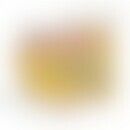Synonym(s)
Head louse; pediculus humanis capitis
DefinitionThis section has been translated automatically.
0.2-0.35 cm long, dorsoventrally flattened, stinging-blood-sucking, wingless insect (stationary ectoparasite) living in hairy head regions, which attaches its eggs (= nits) to the hair close to the base. S.a.u. Pediculosis capitis.
General informationsThis section has been translated automatically.
- Head lice go through 3 stages of development: Fertilized females lay up to 10 eggs/day. Eggs are attached to the head hairs in a water-insoluble way. Head lice live for about one month. Young lice, also called larvae or nymphs, hatch from the eggs after 7-10 days. After several moults, the nymphs reach sexual maturity within 8-10 days. 2-3 days after mating, the females lay the first eggs. The whole cycle lasts 14-28 days and is temperature-dependent.
- Head lice need a blood meal every 2-3 hours, otherwise they dry out and die after 55 hours at the latest. They appear yellowish-brownish and have 6 clasp legs with which they hold on to the hair. They are therefore difficult to remove with a comb. The path of infection is from person to person by migration of the parasites (lice do not jump! and do not travel long distances outside the host). Pets are not carriers of head lice.
You might also be interested in
Occurrence/EpidemiologyThis section has been translated automatically.
Worldwide spread. Close interpersonal contacts, especially in the children's community facilities (school, kindergarten, after-school care), promote the spread.
Complication(s)This section has been translated automatically.
Note(s)This section has been translated automatically.
In contrast to the clothes louse, the head louse is not considered a carrier of infections.
Disclaimer
Please ask your physician for a reliable diagnosis. This website is only meant as a reference.





